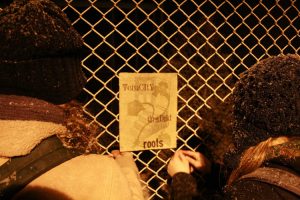The Philadephia-based public installation project Book Bombs started when printmaker Michelle Wilson wrote a note to her friend Mary Tasillo on Facebook about a knitting graffiti project she’d read about. “Look, a yarn bomb,” she said. “We should do a book bomb!”
 Tasillo, who met Wilson in Philadelphia’s University of the Arts’ MFA program for Book Arts/Printmaking, loved the idea of scattering prints around their city, and she wanted to start from the ground up — literally. What if they made the paper themselves? What if they didn’t special order the plant fibers from across the globe (as many fine art papermakers do) but rather harvested the plants themselves?
Tasillo, who met Wilson in Philadelphia’s University of the Arts’ MFA program for Book Arts/Printmaking, loved the idea of scattering prints around their city, and she wanted to start from the ground up — literally. What if they made the paper themselves? What if they didn’t special order the plant fibers from across the globe (as many fine art papermakers do) but rather harvested the plants themselves?
So, in the summer of 2009, Tasillo and Wilson put on their gardening gloves. Philadelphia has many empty lots that are overgrown with mugwort, kudzu, and other invasive plant species. The artists picked them, then cooked and beat them down into pulp to make paper.
“Michelle and I both came to this as papermakers with an interest in sustainability in our art practice,” says Tasillo over pints of porter at a brewery a block from her West Philly home.
Onto these first sheets of paper they used a letterpress to print simple images and arresting messages: “tenacity,” “roots.” When the prints were complete the artists wanted to release them back out into the city that had produced them, but first they thought seriously about how best to display their work. “If you’re print bombing, if you’re anything bombing, you need to think about your relationship to the space,” says Tasillo. Concerned with the ethics of graffiti, they opted not to wheat-paste but to simply tie the prints onto trees and park benches with linen bookbinding thread.
With its social commentary and charming visuals the project has legs. The collaborators have contributed prints to gallery shows in Philadelphia, Baltimore, and California and have lectured at academic conferences. One of their pieces was used in Toronto’s Public Ad Campaign, a takeover of street-level ads intended to reclaim public space from advertisers. The bombers have also produced two photocopied zines, mostly-visual meditations on the themes of the prints, which they distributed the same way they hung their prints.
More bombings are in the works, both in Philadelphia and California, and the artists plan to make interactive installations.
A year after they started bombing the streets with paper installations they have seen an emergence of appreciation for the project. Recently, Wilson noticed a stranger had photographed a print they left in an alley in Philadelphia’s colonial Old City district and made it her Facebook photo. The woman offered to take it down but the artists said “no way.” “We were happy that someone liked it that much.” (Katie Haegele)
Over 15,000 Zine Reviews & Growing!
